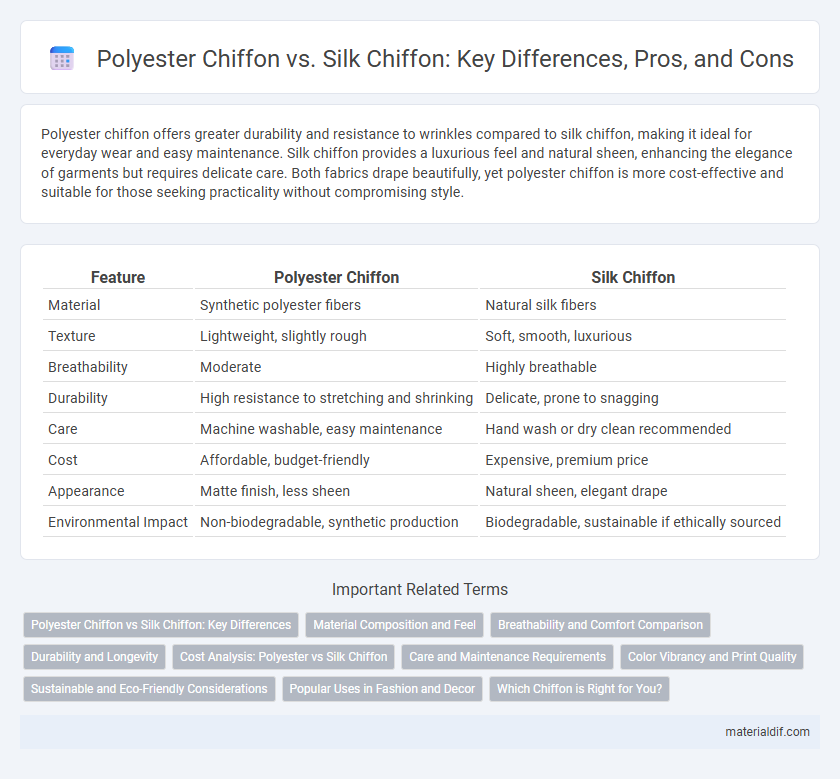Polyester chiffon offers greater durability and resistance to wrinkles compared to silk chiffon, making it ideal for everyday wear and easy maintenance. Silk chiffon provides a luxurious feel and natural sheen, enhancing the elegance of garments but requires delicate care. Both fabrics drape beautifully, yet polyester chiffon is more cost-effective and suitable for those seeking practicality without compromising style.
Table of Comparison
| Feature | Polyester Chiffon | Silk Chiffon |
|---|---|---|
| Material | Synthetic polyester fibers | Natural silk fibers |
| Texture | Lightweight, slightly rough | Soft, smooth, luxurious |
| Breathability | Moderate | Highly breathable |
| Durability | High resistance to stretching and shrinking | Delicate, prone to snagging |
| Care | Machine washable, easy maintenance | Hand wash or dry clean recommended |
| Cost | Affordable, budget-friendly | Expensive, premium price |
| Appearance | Matte finish, less sheen | Natural sheen, elegant drape |
| Environmental Impact | Non-biodegradable, synthetic production | Biodegradable, sustainable if ethically sourced |
Polyester Chiffon vs Silk Chiffon: Key Differences
Polyester chiffon offers enhanced durability and resistance to wrinkles compared to silk chiffon, making it a practical choice for everyday wear and easy maintenance. Silk chiffon provides a natural, breathable fabric with superior softness and a luxurious sheen, ideal for high-end fashion and formal occasions. The cost difference is significant, with polyester chiffon generally more affordable while silk chiffon demands a premium price due to its natural fibers and craftsmanship.
Material Composition and Feel
Polyester chiffon is made from synthetic fibers offering durability, wrinkle resistance, and a slightly stiffer texture compared to silk chiffon, which is derived from natural silk proteins providing a luxurious, soft, and breathable feel. Silk chiffon's natural fiber composition results in a lightweight, smooth fabric with a subtle sheen, ideal for high-end garments, while polyester chiffon tends to be more affordable and easier to care for. The difference in material composition directly impacts their texture, drape, and overall comfort in clothing applications.
Breathability and Comfort Comparison
Polyester chiffon offers durability and resistance to wrinkles but tends to be less breathable compared to silk chiffon, which allows better air circulation and moisture absorption, enhancing comfort during extended wear. Silk chiffon's natural protein fibers provide a lightweight and soft texture that feels gentle on the skin, whereas polyester chiffon may retain heat and cause slight discomfort in warm conditions. When prioritizing breathability and comfort, silk chiffon is preferable for delicate, airy garments, while polyester chiffon suits more budget-conscious or durable fashion choices.
Durability and Longevity
Polyester chiffon offers superior durability and resistance to wrinkles, stains, and shrinking compared to silk chiffon, making it ideal for long-lasting wear. Silk chiffon, while luxurious and breathable, is more delicate and prone to snags, requiring careful handling to maintain its appearance. For extended longevity and easier maintenance, polyester chiffon is the preferred choice in fashion and upholstery applications.
Cost Analysis: Polyester vs Silk Chiffon
Polyester chiffon is significantly more affordable than silk chiffon, making it a popular choice for budget-conscious consumers and large-scale productions. The manufacturing cost of polyester, derived from synthetic fibers, is lower compared to the natural silk process, which requires labor-intensive cultivation and harvesting of silkworm cocoons. While silk chiffon offers superior breathability and luxurious texture, polyester chiffon provides a cost-effective alternative without compromising on the lightweight and sheer qualities desired in chiffon fabrics.
Care and Maintenance Requirements
Polyester chiffon requires minimal care with its wrinkle-resistant and durable fibers, allowing for easy machine washing and quick drying. Silk chiffon demands delicate handling, often needing hand washing or dry cleaning, and strict avoidance of harsh detergents or prolonged exposure to sunlight to maintain its softness and sheen. While polyester chiffon offers high resistance to stretching and shrinking, silk chiffon is more prone to damage from moisture and abrasion, necessitating extra caution during wear and cleaning.
Color Vibrancy and Print Quality
Polyester chiffon exhibits superior color vibrancy due to its synthetic fibers that hold dyes more effectively than silk chiffon, which tends to have softer, more muted hues. Print quality on polyester chiffon is sharper and more defined, benefiting from the fabric's smooth surface and strong dye affinity. Silk chiffon, however, offers a more delicate print with a natural sheen, but it may experience color fading and less precise detailing over time.
Sustainable and Eco-Friendly Considerations
Polyester chiffon, made from synthetic fibers, typically has a larger environmental footprint due to non-renewable petrochemical sources and energy-intensive manufacturing processes. Silk chiffon, derived from natural silk fibers, is biodegradable and renewable but involves ethical concerns related to sericulture and higher water usage. Choosing sustainably produced organic polyester or ethically sourced silk can mitigate some environmental and eco-friendly challenges associated with chiffon fabrics.
Popular Uses in Fashion and Decor
Polyester chiffon is favored in fashion for its affordability, durability, and ease of care, commonly used in evening gowns, blouses, and scarves. Silk chiffon, valued for its luxurious texture and natural sheen, is preferred in high-end couture, bridal wear, and delicate drapery in home decor. Both fabrics enhance garment flow and aesthetic appeal, but polyester chiffon dominates budget-friendly fashion and versatile decorative applications.
Which Chiffon is Right for You?
Polyester chiffon offers affordability, durability, and ease of care, making it an ideal choice for everyday wear or budget-conscious projects. Silk chiffon provides superior softness, natural breathability, and a luxurious drape, perfect for high-end fashion and special occasions. Choosing between polyester and silk chiffon depends on your priorities for cost, fabric feel, and garment longevity.
Polyester Chiffon vs Silk Chiffon Infographic

 materialdif.com
materialdif.com